Last we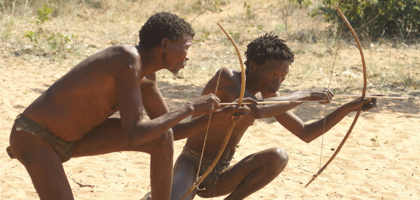 ekend, the Netherlands played a practice match for the upcoming European Championships against Israel. Holland was represented by the squad that won the Bermuda Bowl in Veldhoven last year, and will also be playing at the Europeans, Israel fielded the team that won the Transnational Teams at the same venue. Both teams are amongst the favorites for the title at the European Championships later this year. In short, this is a match between 2 of the strongest teams you can find today.
ekend, the Netherlands played a practice match for the upcoming European Championships against Israel. Holland was represented by the squad that won the Bermuda Bowl in Veldhoven last year, and will also be playing at the Europeans, Israel fielded the team that won the Transnational Teams at the same venue. Both teams are amongst the favorites for the title at the European Championships later this year. In short, this is a match between 2 of the strongest teams you can find today.
By the way, I have been at the venue where the Europeans will be played and while it is a very nice place, it is far away from everything and taxis are hard to get in particular around dinner time. If you want to go off-site for meals and such, rent a car.
The venue of the event was ‘t Onstein, which is close to where I live. I had an afternoon to spare on Friday, so time to go and kibitz. The format of the event was a double team match, that is, all 3 pairs of a team play a 16 board session at the same time, 2 pairs as NS and 1 as EW (or the other way around), after 16 boards, both NS pairs compare scores with the EW pair. That makes some decisions twice as expensive as usual, take this one from session 2, for example:
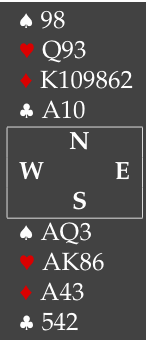 You open 1NT, pass on your left, partner bids 3♣ as a transfer to ♦, you bid 3♦ and partner bids 3NT. The opening lead is the ♣3, 10, J, 2. Back comes the ♣6, 4, K and you win your ace. Now the ♦10 from dummy, ♦J, ♦A and ♦5. You cash 2 high hearts ending in hand, but now you have to make a decision in the diamond suit. ♦3, ♦7, and your choice?
You open 1NT, pass on your left, partner bids 3♣ as a transfer to ♦, you bid 3♦ and partner bids 3NT. The opening lead is the ♣3, 10, J, 2. Back comes the ♣6, 4, K and you win your ace. Now the ♦10 from dummy, ♦J, ♦A and ♦5. You cash 2 high hearts ending in hand, but now you have to make a decision in the diamond suit. ♦3, ♦7, and your choice?
This is a classical restricted choice situation. With ♦QJ, RHO has a choice which diamond to play, with a singleton ♦J, all he can do is to play the ♦J. That makes it more likely that he has a singleton ♦J. Also, the double of 3♣ and early play suggests long clubs with RHO, thus short diamonds. So, I think Ilan Herbst made the right play by sticking in the ♦9. He was wrong in practice, RHO had started with ♦QJ. Down 1, losing 22 imp’s when the 2 other tables made 3NT. Unlucky? Yes, he made the decision at the table that counted twice and only with his methods, his opponent got a chance to make a lead directing double of clubs.
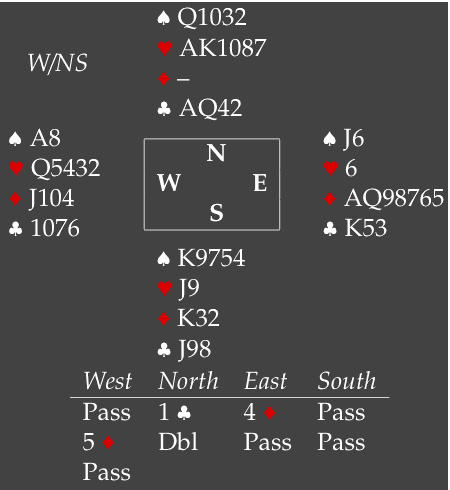 The next board showed a classic case of over-preempting: 1♣ was strong (16+) and double showed extra’s. South obviously had no idea what to do and decided to go for the sure plus score.5♦x indeed went down 3 for a few imp’s gain against 4♠.
The next board showed a classic case of over-preempting: 1♣ was strong (16+) and double showed extra’s. South obviously had no idea what to do and decided to go for the sure plus score.5♦x indeed went down 3 for a few imp’s gain against 4♠.
I think EW bid too much here, over 5♦, there is little NS can do but double and hope for the best, but now look at the hand when west doesn’t raise to 5♦. Again north will double but now south has a choice. Suppose he bids 4♠, as seems reasonable opposite the expected 3-suiter in north. What is north going to do? Slam is still possible (change the ♣K and ♦K, for example), on the other hand, declarer must get spades right in 5♠. You sometimes have to give the opponents a chance to get it wrong.
In the 3rd session, I was kibitzing Verhees and van Prooijen and this hand for system-freaks came up. If you are not in that category, skip the next 3 paragraphs.
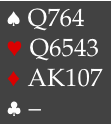 Some background: Verhees and van Prooijen play an unusual system (“Ultimate Canape”) based on a strong 1♣ opening, canape opening bids and a lot of relays originating from the “Ultimate Club” system of the 1970‘s. The 2♣ opening shows 10-15 and either 6♣, or a 2 suiter with 4♣ and 5+♠. Do you pass or make a bid? I’m not going to ask to specify the bid, which is simply impossible to answer if your are not familiar with the system, just decide between pass and something else.
Some background: Verhees and van Prooijen play an unusual system (“Ultimate Canape”) based on a strong 1♣ opening, canape opening bids and a lot of relays originating from the “Ultimate Club” system of the 1970‘s. The 2♣ opening shows 10-15 and either 6♣, or a 2 suiter with 4♣ and 5+♠. Do you pass or make a bid? I’m not going to ask to specify the bid, which is simply impossible to answer if your are not familiar with the system, just decide between pass and something else.
Canape is a method where the shorter of 2 suits is bid first, followed by the longer. A simple example is the auction 1♠-1NT-2♦. In Canape, this shows 5♦ and 4♠, as opposed to the standard 5♠ and 4♦. One of the disadvantages of this method is that hands with 5♠ and 4♣ and about 11-15 hcp become hard to bid, 1♣ shows 16+ and 1♠ followed by 2♣ gets the suit lengths wrong. Over the years, lots of solutions for this problem have been invented, Ultimate Canape solves it by using the 2♣ opener to show 10-15 with either 6♣ (as is common in a strong club system) or 4♣ and 5+♠.
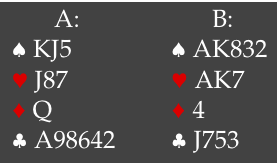 When I first saw this approach, I wondered if this was playable at all, as these are 2 completely different hand types shown at a level where responder may have to make the final decision with little information. That was the case here too, partner can easily have hand A or B. In one case, you are cold for 7♠, in the other it is a complete misfit and 2♣ is the last possible positive score. Needless to say, Verhees hoped for A but found partner with B. It cost a few imp’s. The 2♣ opener came up once more in the session, for another loss. I first saw this approach in 1993 and it didn’t struck me as a good idea back then, 20 years later, I’m still not convinced.
When I first saw this approach, I wondered if this was playable at all, as these are 2 completely different hand types shown at a level where responder may have to make the final decision with little information. That was the case here too, partner can easily have hand A or B. In one case, you are cold for 7♠, in the other it is a complete misfit and 2♣ is the last possible positive score. Needless to say, Verhees hoped for A but found partner with B. It cost a few imp’s. The 2♣ opener came up once more in the session, for another loss. I first saw this approach in 1993 and it didn’t struck me as a good idea back then, 20 years later, I’m still not convinced.
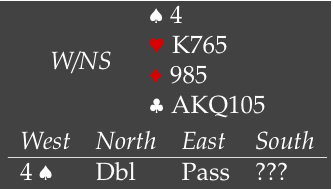 Finally, this hand, one of the better bidding problems that I ran across in the last months. Usually, bidding forums require that there are at least 3 good answers to a problem before publishing it. This has at least 6, there is a case to be made for pass, 4NT, 5♣, 5♥, 5♠ and 5NT. As I don’t have a clue about the correct answer myself, I’ve set up a poll. Click here to participate, it will open a new window where you can enter your bid. I’ll post the results in a couple of days.
Finally, this hand, one of the better bidding problems that I ran across in the last months. Usually, bidding forums require that there are at least 3 good answers to a problem before publishing it. This has at least 6, there is a case to be made for pass, 4NT, 5♣, 5♥, 5♠ and 5NT. As I don’t have a clue about the correct answer myself, I’ve set up a poll. Click here to participate, it will open a new window where you can enter your bid. I’ll post the results in a couple of days.
After 3 days and 144 boards, Israel had won the match 598-457. Note that this is with 2 comparisons per board, a regular match would have ended around 300-225 imps. 75 imps is a lot, the new Dutch coach has a lot of work to do to get his team ready for Dublin.
